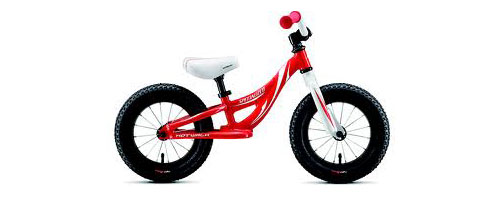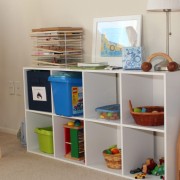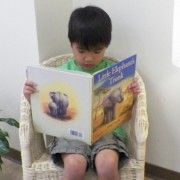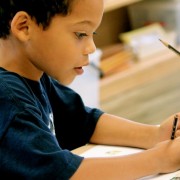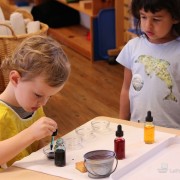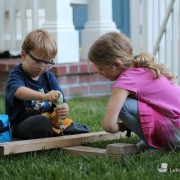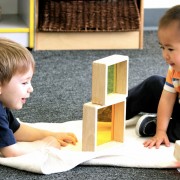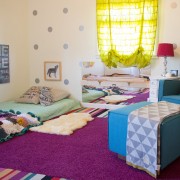Balance Bikes and Montessori
It never ceases to amaze us how joyfully Montessori preschool children learn advanced skills, and at such early ages. In our preschool classes, we often see 4-year-olds writing in cursive, 5-year-olds reading chapter books, and 6-year-old doing arithmetic into the thousands.
We know the reason: a prepared environment. When a preschool child is able to explore and experience materials designed to meet his particular capacities, he learns naturally and easily.
There’s no reason these same Montessori principles cannot be extended to the home environment. As parents, we can be on the lookout for materials that help our preschool-aged children learn other skills just as joyfully and early as they do in their preschool classroom.
A great example is bike riding. When my daughter was 3 ½ years old, she was able to ride a bike without training wheels. This is not because she has innately superior motor skills, but because she had the right materials. Instead of relying on training wheels to have her first biking experience, she learned with a balance bike (also called a running bike or striding bike, or pedal-less bike.)
A balance bike is a very small frame bicycle without pedals and without training wheels. A child as young as age two can sit on the saddle, and push off with his feet to move forward. Initially, children may just walk slowly, standing over the saddle, but as they gain confidence, they sit down, pushing faster and faster. Ultimately, they gain enough speed to lift up their feet and coast along, balancing on the bike. They breeze down hills, leaning into curves. They use the handbrake to slow themselves down, and put their feet up on foot pegs whizzing down hills. They learn all the skills for riding a bike (other than pedaling), effortlessly and playfully.
Balance bikes make learning to ride a bike effortless and fun, the same way Montessori preschool does for other skills:
- Isolating the challenge. In Montessori preschool, we separate out component skills and teach them separately, in a way that makes learning each skill motivating. For example, the Metal Insets allow preschoolers to practice pencil control with an activity the child enjoys. Similarly, the balance bike isolates the challenge of learning to balance a bike, and makes it easy to master, in a step-by-step progression.
- Establishing correct habits, from the get-go. Undoing bad habits is hard work, unnecessary hard work. That’s why Montessori preschoolers learn key skills correctly from the beginning, whether it is holding a pitcher correctly when pouring, completing a work cycle by returning the activity to the proper place on the shelf, or learning to write in cursive in preschool. Learning to bike with training wheels teaches bad habits: children learn to expect the bike to stay upright when not moving, as the training wheels allow the bike to do that. But real bikes actually require movement to stay upright! So when you take the training wheels away from a 5-year-old, he has to unlearn the bad habit of stopping with his feet on the pedals. That’s in part why it is often a struggle to get children to give up their training wheels!
- Making learning fun: the “follow the child” approach. We all learn best when the learning process itself is fun. We like to try things independently, figure them out by ourselves, without constant corrections by well-meaning teachers. That’s why, in Montessori preschool, materials are designed so that they draw the children in, with a “control of error” built into the materials. The same is true with a balance bike: riding these little bikes is lots of fun for the children, and they can slowly, on their own, progress from just walking with the bike, to running with it, to ultimately lifting up their feet for longer and longer periods. No adult coaching or intervention is needed: the child is in charge, and he basically teaches himself the skill of balancing, in a fun, effortless, self-correcting way.
- Learning skills during sensitive periods. In Montessori, we believe that children have specific sensitive periods, during which learning happens naturally and effortlessly. For instance, we see every day that learning beautiful handwriting is much easier done at ages 4-5, then in 3rd grade. The same is true for learning to ride a bike: with a balance bike, learning to balance on a bike is as natural for a 3-year-old as learning to walk; as many parents witness, learning to ride a bike later on can be much more of a struggle!
This summer, when you think about fun activities with your preschool aged child (for the time she’s not at Montessori summer camp!), consider buying her a balance bike. Take her to the park, and let her go. Watch, and see her skills develop: it’s great fun for the children, and so wonderful as a mother or father to see them proudly and confidently applying their growing skills in the park and on family bike rides!
(There’s a great video here of a 4 ½ year old boy learning to ride a balance bike, showing him progressing over 2 ½ weeks from walking to really riding!)

